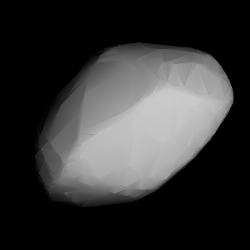
749 Malzovia is a stony background asteroid from the inner regions of the asteroid belt, approximately 11 kilometers in diameter. It was discovered on 5 April 1913, by Russian astronomer Sergey Belyavsky at the Simeiz Observatory on the Crimean peninsula. The elongated S-type asteroid has a rotation period of 5.9 hours. It was named after Russian amateur astronomer Nikolai Maltsov who founded the discovering Simeïs Observatory in 1900.

849 Ara is a large, metallic background asteroid, approximately 80 kilometers in diameter, that is located in the outer region of the asteroid belt. It was discovered on 9 February 1912, by Russian astronomer Sergey Belyavsky at the Simeiz Observatory on the Crimean peninsula. The M-type asteroid has a short rotation period of 4.1 hours and is likely elongated in shape. It was named after the American Relief Administration (ARA) for the help given during the Russian famine of 1921–22.
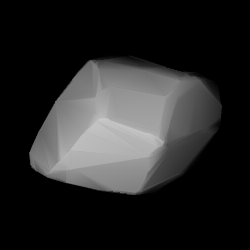
877 Walküre is a dark background asteroid from the inner regions of the asteroid belt, approximately 38 kilometers in diameter. It was discovered on 13 September 1915, by Russian astronomer Grigory Neujmin at the Simeiz Observatory on the Crimean peninsula. The carbonaceous F/C-type asteroid has a rotation period of 17.4 hours and is likely elongated in shape. It was named after the female spirit Valkyrie from Norse mythology, best known from Wagner's opera Die Walküre.

979 Ilsewa is a background asteroid from the outer regions of the asteroid belt, approximately 36 kilometers in diameter. It was discovered by German astronomer Karl Reinmuth at the Heidelberg-Königstuhl State Observatory on 29 June 1922. The uncommon T-type asteroid has a longer-than average rotation period of 42.6 hours. It was named after Ilse Walldorf, an acquaintance of the discoverer.
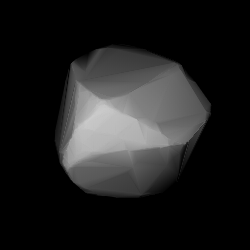
986 Amelia is a large background asteroid from the outer regions of the asteroid belt, approximately 50 kilometers in diameter. It was discovered on 19 October 1922, by Spanish astronomer Josep Comas i Solà at the Fabra Observatory in Barcelona. The L/D-type asteroid has a rotation period of 9.5 hours. It was named after the discoverer's wife, Amelia Solà.

1089 Tama, provisional designation 1927 WB, is an elongated Florian asteroid and synchronous binary system from the inner regions of the asteroid belt, approximately 12 kilometers in diameter.

1514 Ricouxa, provisional designation 1906 UR, is a stony Florian asteroid from the inner regions of the asteroid belt, approximately 7.5 kilometers in diameter. It was discovered on 22 August 1906, by German astronomer Max Wolf at Heidelberg Observatory in southern Germany. The origin of the asteroid's name is unknown.
1065 Amundsenia, provisional designation 1926 PD, is a stony asteroid and sizeable Mars-crosser on an eccentric orbit from the inner asteroid belt, approximately 10 kilometers in diameter. It was discovered on 4 August 1926, by Soviet astronomer Sergey Belyavsky at the Simeiz Observatory on the Crimean peninsula. The asteroid was named after Norwegian polar explorer Roald Amundsen.
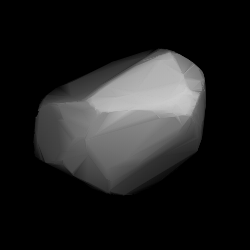
1088 Mitaka is a bright background asteroid from the inner regions of the asteroid belt. It was discovered on 17 November 1927, by Japanese astronomer Okuro Oikawa at the old Tokyo Astronomical Observatory in Japan. The stony S-type asteroid has a notably short rotation period of 3.0 hours and measures approximately 15 kilometers in diameter. It was named after the Japanese village of Mitaka.

1140 Crimea, provisional designation 1929 YC, is a stony asteroid from the middle region of the asteroid belt, approximately 28 kilometers in diameter. It was discovered on 30 December 1929, by Soviet astronomer Grigory Neujmin at Simeiz Observatory on the Crimean peninsula, after which it was named.
1453 Fennia, provisional designation 1938 ED1, is a stony Hungaria asteroid and synchronous binary system from the innermost regions of the asteroid belt, approximately 7 kilometers in diameter. Discovered by Yrjö Väisälä at the Turku Observatory in 1938, the asteroid was later named after the Nordic country of Finland. The system's minor-planet moon was discovered in 2007. It has a derived diameter of 1.95 kilometers and is orbiting its primary every 23.55 hours.

1188 Gothlandia, provisional designation 1930 SB, is a stony Florian asteroid from the inner regions of the asteroid belt, approximately 12 kilometers in diameter. Discovered by astronomer Josep Comas i Solà at the Fabra Observatory in 1930, the asteroid was later named after the ancient name of the Spanish autonomous community of Catalonia.
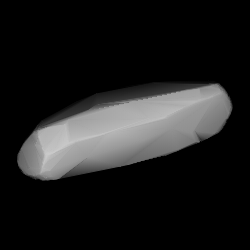
2156 Kate is a highly elongated background asteroid from the inner regions of the asteroid belt. The asteroid was discovered on 23 September 1917, by Soviet–Russian astronomer Sergey Belyavsky at the Simeiz Observatory on the Crimean peninsula. It was named for Kate Kristensen, wife of astronomer L. K. Kristensen. The bright S-type/A-type asteroid has a rotation period of 5.6 hours and measures approximately 8 kilometers in diameter.
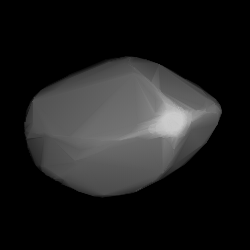
1379 Lomonosowa is a stony background asteroid from the central regions of the asteroid belt, approximately 19 kilometers in diameter. Discovered by Grigory Neujmin at the Simeiz Observatory in 1936, the asteroid was later named after Russian physicist and astronomer Mikhail Lomonosov.

1350 Rosselia, provisional designation 1934 TA, is a stony Koronian asteroid from the outer regions of the asteroid belt, approximately 22 kilometers in diameter. Discovered by astronomer Eugène Delporte at the Royal Observatory of Belgium in 1934, the asteroid was later named after Marie-Thérèse Rossel, editor of the Belgian newspaper Le Soir.
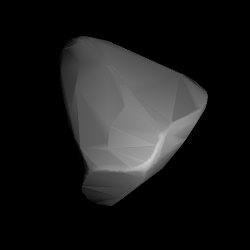
1494 Savo, provisional designation 1938 SJ, is a stony background asteroid from the inner region of the asteroid belt, approximately 8 kilometers in diameter. Discovered by astronomer Yrjö Väisälä at the Turku Observatory in 1938, the asteroid was later named after the Finnish region of Savonia.

32532 Thereus, provisional designation: 2001 PT13, is a centaur from the outer Solar System, approximately 80 kilometers (50 miles) in diameter. It was discovered on 9 August 2001, by astronomers of the Near-Earth Asteroid Tracking program at the Palomar Observatory in California, United States. This minor planet was named for the phrase thēreios bia 'beastly strength', used to describe centaurs in Greek mythology.

1619 Ueta, provisional designation 1953 TA, is a stony asteroid from the inner regions of the asteroid belt, approximately 11 kilometers in diameter. It was discovered on 11 October 1953, by Japanese astronomer Tetsuyasu Mitani at Kyoto University's Kwasan Observatory, near Kyoto, Japan. It was named after the former director of the discovering observatory.
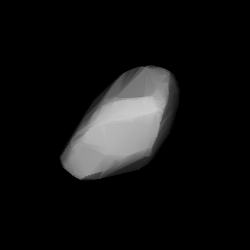
1339 Désagneauxa, provisional designation 1934 XB, is a stony Eoan asteroid from the outer region of the asteroid belt, approximately 24 kilometers in diameter. It was discovered on 4 December 1934, by French astronomer Louis Boyer at the North African Algiers Observatory in Algeria. A few nights later, the asteroid was independently discovered by astronomers Grigory Neujmin and Eugène Delporte, at the Crimean Simeiz and Belgian Uccle Observatory, respectively. It was later named after discoverer's brother-in-law.
(15700) 1987 QD, provisional designation 1987 QD, is a Mars-crossing asteroid and a binary candidate from inside the innermost region of the asteroid belt, approximately 3 kilometers in diameter. It was discovered on 24 August 1987, by American astronomer Stephen Singer-Brewster at the Palomar Observatory in California. The likely spherical X-type asteroid has a rotation period of 3.1 hours. The suspected presence of a kilometer-sized minor-planet moon was announced in November 2000.

















